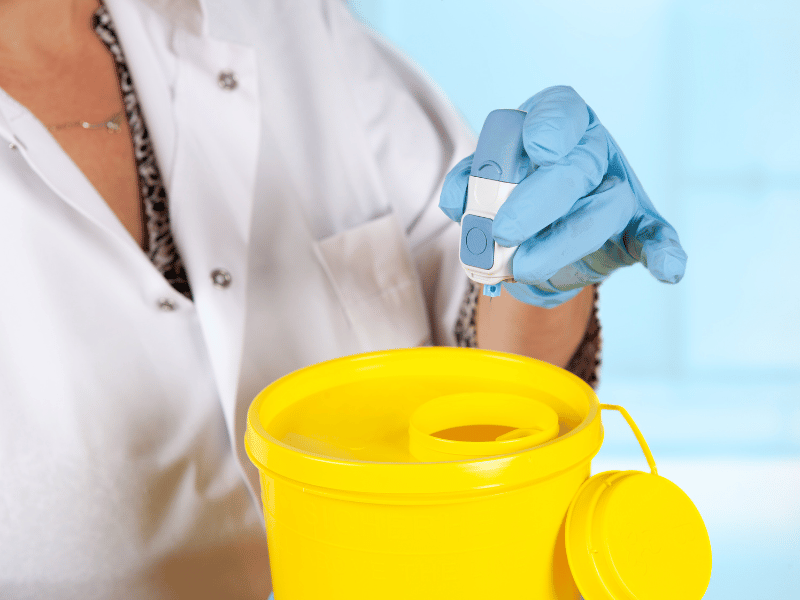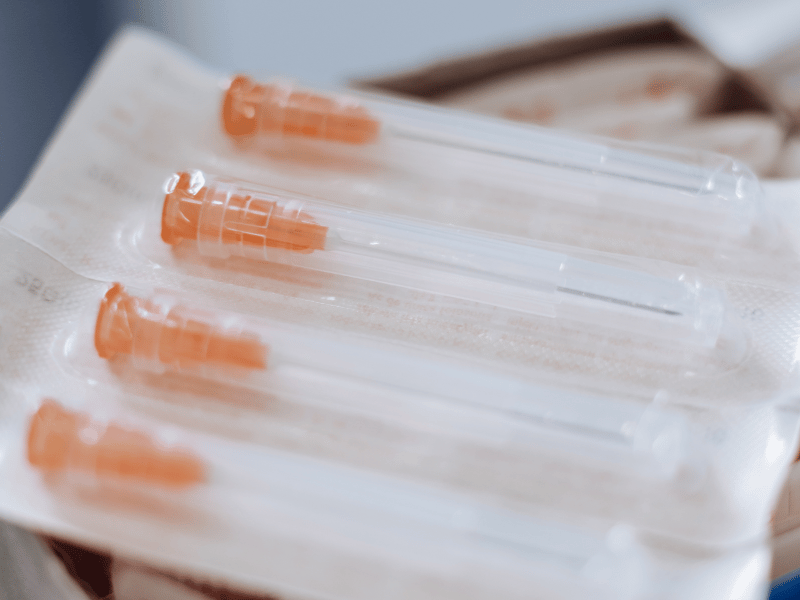Healthcare staff are at at increased risk of needlestick injury, which can lead to fatal infections.
Thankfully, OSHA guidelines for needle sticks help protect healthcare employees from needlestick injuries. Here is a handy and straightforward guide on OSHA needlestick prevention.
Table of Contents

OSHA Needlestick Protocol Overview
The OSHA needle stick protocol pertains to the set of OSHA standards that protect health workers from sharps injuries caused by needles, which can lead to exposure to blood and other body fluids. The National Institute for Occupational Safety and Health (NIOSH) says that needlestick injuries are usually caused by:
- Not using safety-engineered sharps or using them inappropriately
- Recapping needles
- Transferring body fluids between containers
- Improperly disposing of used needles in puncture-resistant sharps containers
Importance of OSHA Needlestick Protocol
A study from the International Journal of General Medicine shows that around 385,000 sharps injuries happen yearly among hospital employees in the U.S. These needlestick incidents may lead to exposure to bloodborne pathogens like hepatitis B (HBV), hepatitis C (HCV), and human immunodeficiency virus (HIV). Sadly, sharps injuries are often underreported, leading to dangerous work-related incidents. The OSHA needlestick protocol aims to protect workers from injury, illness, or death caused by needlesticks.

OSHA Needlestick Protocol Guidelines
Standard 29 CFR 1910.1030 on bloodborne pathogens provides guidelines on the OSHA process on needlestick incidents. These guidelines are adapted from the OSHA FactSheet on Bloodborne Pathogens Standard, which summarizes 29 CFR 1010.1930. Employers should still refer to the original document for detailed guidelines.
Develop a written exposure control plan
The employer should draft an exposure determination outlining job classifications in two categories: all employees are at risk of needlestick incidents, and only certain workers encounter them. The determination should also detail workers’ tasks and procedures that lead to exposure.
Update the plan yearly
The plan should be revised annually, incorporating any changes in responsibilities, tasks, or processes that affect work-related incidents. Employers should also include if they considered and adopted safer medical devices, such as needleless technology, to help lessen or prevent needlestick injuries. Furthermore, employers should record gathered feedback from frontline workers to identify, assess, and select the best engineering and work practice controls.
Implement the use of universal precautions
All human blood and Other Potentially Infectious Materials (OPIM) should be treated as if they are known to be infectious for bloodborne pathogens. Regardless of the perceived status of the blood or OPIM, precautions should be taken to prevent exposure to bloodborne pathogens. In this case, it’s better to assume the worst rather than be sorry in the future.
Use engineering controls
Engineering controls are physical or mechanical solutions that isolate or eliminate exposure to bloodborne pathogens hazards in your workplace. Employers should consider using medical devices such as sharps disposal containers, syringes with safety protection, needle-free injections, and splash guards. The Texas Health and Human Services list of registered needless systems and sharps devices can help you find an appropriate device.
Improve work processes
Faulty work processes can sometimes lead to OSHA violations and needlestick incidents. Improving workplace practices can help reduce potential exposure to bloodborne pathogens caused by needlesticks. For example, employers should assess whether healthcare staff has disposed of contaminated needles properly, according to the standards of biohazard waste disposal. They should also check if their facilities have readily available puncture-proof containers. Furthermore, they should have a system for reporting improperly disposed of needles.
Provide free PPE
Different OSHA standards, including the one on bloodborne pathogens, require employers to provide personal protective equipment to employees at no cost. If the employee’s job exposes him to needlesticks, employers should give them the appropriate attire, including gloves, eye masks or shields, and closed-toe shoes.
Vaccinate workers against hepatitis B
Healthcare workers exposed to needlesticks should be vaccinated against HBV for free. The vaccination should be given after the employee completes the required training and within ten working days of their initial assignment. If the employee declines the vaccination, the employer should make him sign the statement in Appendix A in the standard. If the employee changes their mind, the employer should still give them the vaccination for free.

Provide post-exposure evaluation and follow-up to exposed workers
Healthcare staff occupationally exposed to blood or OPIM should undergo free evaluation and follow-up. This process should include documentation of the route of exposure and how the exposure happened unless it’s impossible to do so. Employers should get consent from employees before determining HBV and HIV infectivity. If the employee doesn’t consent, it’s up to the employer to establish that legally required consent cannot be obtained.
Use warning labels
Hazard communication is an important aspect of OSHA standards for needlestick injury prevention. Employers should ensure that refrigerators, freezers, and other containers of contaminated needles are clearly labeled. As an alternative, they can also use red bags or red containers. Signage should also be present on all access doors in HIV and HBV research labs and production facilities with OPIM or infected animals.
Educate and train workers
Employers are responsible for regularly training workers with occupational exposure to needlesticks and other sharps. The training should be conducted by a person knowledgeable on the subject matter. Additional training is required for staff working in HIV and HBV laboratories and production facilities.
Keep records of occupational exposure
Employers should follow the standards of the OSHA 300 log to keep accurate records of occupational exposure. Employers with ten or fewer employees are exempted from routinely keeping records as required in Part 1904-Recording and Reporting Occupational Injuries and Illnesses. However, any serious workplace incident that results in a fatality or in-patient hospitalization should still be reported to OSHA immediately, according to the required timeframes.







